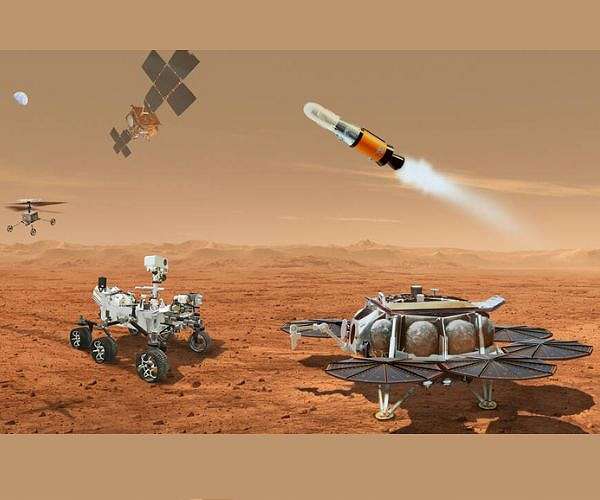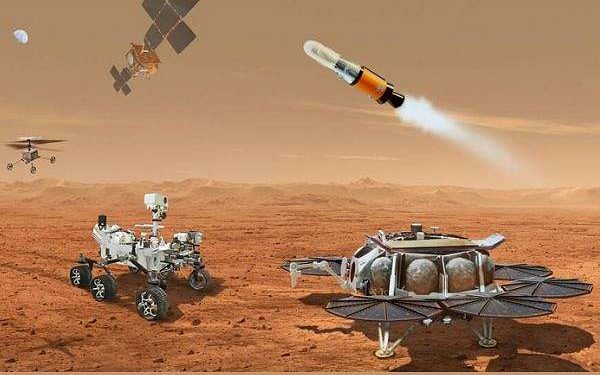
NASA seeks faster, more affordable Mars sample return mission
by Mike Heuer
Space Coast FL (SPX) Jun 05, 2024
NASA officials want a new Mars sample return mission plan that is faster, costs less and isn’t as complex than one scrapped in April.
The space agency doesn’t want to wait until 2040 and spend $11 billion to return core samples being collected on Mars, which the recently scrapped plan would have required.
NASA Administrator Bill Nelson in April canceled the lengthy mission plan, saying he wants to see collaboration on a less-pricey mission design that also reduces complexity and risk.
“The bottom line is, an $11 billion budget is too expensive and a 2040 return date is too far away,” Nelson said in an April 15 news release. He said he wants a new plan that will accomplish the mission in the 2030s.
Nelson said safely landing a spacecraft on Mars, collecting the samples and launching a rocket containing the samples off another plant never has been done. The Perseverance rover has collected rock samples, but that’s where the process ends for now.
“We need to look outside the box to find a way ahead that is both affordable and returns samples in a reasonable time frame,” he said.
If the sample collection and return launch from Mars are successful, the spacecraft would have to travel more than 33 million miles to Earth, which Nelson said is “no small task.”
“The Mars sample return mission is one of the most complex science missions NASA has ever attempted,” NASA officials told UPI in an email.
“NASA intends to hold Mars sample return costs to no more than 35% of the annual budget for the Planetary Science Division,” space agency officials said. NASA allocated $310 million for its 2024 Mars sample return budget and seeks $200 million for 2025.
NASA officials want an updated mission design with a total budget closer to $8 billion, and on April 16 issued a request for proposals from industry, NASA centers and the Jet Propulsion Laboratory that leverage innovation and proven technologies.
Nelson said he wanted an alternate plan by fall.
The original plan relied on the European Space Agency’s Earth return orbiter and the agency’s capture containment and return system. It also included contributions from Lockheed Martin.
That contractor was to have received $35 million for the Mars lander’s cruise stage, $194 million for a Mars ascent vehicle and $2.6 million to design an Earth entry system.
It’s unknown if the new plan would include Lockheed Martin contributions.
As with many space projects, the projected cost has risen sharply from that initial estimate of $5.3 billion. That amount proved to be only about half the revised $11 billion cost estimate to retrieve samples gathered by Perseverance.
George Scott, acting inspector general of NASA, identified several problems with the initial $5.3 billion cost estimate in testimony before the House Committee on Science, Space and Technology Subcommittee on Space and Aeronautics on March 21.
The initial budget, he said, anticipated 2% inflation when the idea was developed in 2020 to late 2021, but actual inflation rates ranged from 5% to 9% from late 2021 to early 2023. Also, a sample-receiving facility — and its cost — wasn’t included.
Moreover, the European Space Agency didn’t provide the mission a sample fetch rover it promised, so NASA planned to replaced that with sample recovery helicopters at considerable cost.
Also, the $5.3 billion funding estimate was only is for costs incurred from 2023 to 2032 and not the program’s entire life cycle.
Scott referred to a 2020 Science Mission Directorate report that notes NASA’s early cost estimates commonly have a high degree of precision but poor accuracy.
It says precise but inaccurate cost estimates create a “false sense of confidence in early numbers and timelines, leading stakeholders to latch onto these inaccurate preliminary estimates.”
False confidence in inaccurate estimates “can unrealistically constrain the project in later phases,” according to the report.
NASA’s sent Perseverance to Mars in 2020, and it started collecting samples in 2021. It continues exploratory drilling of core samples. that need eventual collection.
The rover has collected 38 samples that are stored in tubes, which represents about two-thirds of its sample-collecting capability, NASA noted.
Returning those samples from Mars is a “key priority,” said Nicola “Nicky” Fox, associate administrator of NASA’s Science Mission Directorate.
“Our next steps will position us to bring this transformational mission forward and deliver revolutionary science from Mars,” Fox said in an April 15 news release.
The samples should provide “critical new insights into the origins and evolution of Mars, our solar system and life on Earth,” she added.
If a new plan is developed, travel to Mars, collecting the samples and returning would take a year to two years, depending on the propulsion system used, officials have said.
NASA anticipates having a viable plan by the end of the year.
Source: United Press International
Related Links
Mars Sample Return
Mars News and Information at MarsDaily.com
Lunar Dreams and more
